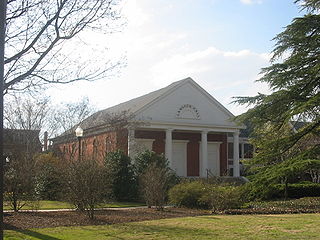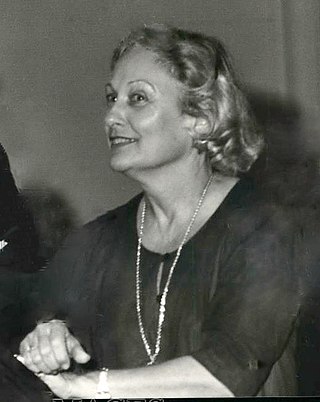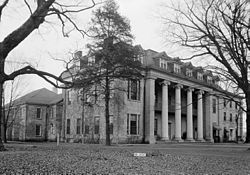
Limestone County is a county of the U.S. state of Alabama. As of the 2020 census, the county's population was 103,570. Its county seat is Athens. The county is named after Limestone Creek. Limestone County is included in the Huntsville, AL Metropolitan Statistical Area.

Columbia is a town in Houston County, Alabama, United States. It is part of the Dothan, Alabama Metropolitan Statistical Area. At the 2010 census the population was 740, down from 804 in 2000.

Athens is a city in and the county seat of Limestone County, in the U.S. state of Alabama; it is included in the Huntsville-Decatur-Albertville, AL Combined Statistical Area. As of the 2020 census, the population of the city is 25,406.

The University of North Alabama (UNA) is a public university in Florence, Alabama. It is the state's oldest public university. Occupying a 130-acre (0.5 km2) campus in a residential section of Florence, UNA is located within a four-city area that also includes Tuscumbia, Sheffield and Muscle Shoals. The four cities compose a metropolitan area with a combined population of 140,000 people.

Huntingdon College is a private Methodist college in Montgomery, Alabama. It was founded in 1854 as a women's college.

Cahaba, also spelled Cahawba, was the first permanent state capital of Alabama from 1820 to 1825, and the county seat of Dallas County, Alabama until 1866. Located at the confluence of the Alabama and Cahaba rivers, it suffered regular seasonal flooding.

Andrew Adgate Lipscomb was an American clergyman and educator.

Gary Eugene Redus is an American former professional baseball outfielder who played in Major League Baseball (MLB) for the Cincinnati Reds, Philadelphia Phillies, Chicago White Sox, Pittsburgh Pirates, and Texas Rangers.
A comprehensive regional university today, the University of North Alabama traces its beginnings to the first half of the 19th century, when the Methodist Episcopal Church sought to bring learning and culture to an obscure mountain in Alabama.

The Forks of Cypress was a large slave-labour cotton farm and Greek Revival plantation house near Florence in Lauderdale County, Alabama, United States. It was designed by architect William Nichols for James Jackson and his wife, Sally Moore Jackson. Construction was completed in 1830. It was the only Greek Revival house in Alabama with a two-story colonnade around the entire house, composed of 24 Ionic columns. The name was derived from the fact that Big Cypress Creek and Little Cypress Creek border the plantation and converge near the site of the main house. Although the main house was destroyed by fire in 1966 after being struck by lightning, the site was placed on the Alabama Register of Landmarks and Heritage on April 14, 1992 and the National Register of Historic Places on October 10, 1997. The site is the property of the State of Alabama; a local board has oversight.

Langdon Hall is a building on the campus of Auburn University in Auburn, Alabama, United States. Built in the Greek Revival style in 1846 as the chapel for the Auburn Female College and moved to the Auburn University campus in 1883, Langdon Hall is the oldest building in the city of Auburn, and today houses an auditorium and office space for Auburn University staff. Before the Civil War, Langdon Hall served as the location for a series of debates on the question of Southern secession, involving William Lowndes Yancey, Alexander Stephens, Benjamin Harvey Hill, and Robert Toombs. Langdon Hall is named for Charles Carter Langdon, a former mayor of Mobile, Alabama, Alabama Secretary of State, and a trustee of Auburn University from 1872–1889.
The Greensboro Historic District is a historic district in the city of Greensboro, Alabama. Greensboro was incorporated as a town in December 1823 as Greensborough. The community was known as Troy prior to that time. The historic district is centered on Main Street and runs from Hobson Street on the western side of the city to 1st Street on the eastern side. It features examples of Federal, Greek Revival, and regional vernacular architecture. One significant contributing property is Magnolia Hall. It was placed on the National Register of Historic Places on August 13, 1976.

The Gorgas–Manly Historic District is a historic district that includes 12 acres (4.9 ha) and eight buildings on the campus of the University of Alabama in Tuscaloosa, Alabama. The buildings represent the university campus as it existed from the establishment of the institution through to the late 19th century. Two buildings included in the district, Gorgas House and the Little Round House, are among only seven structures to have survived the burning of the campus by the Union Army, under the command of Brigadier General John T. Croxton, on April 4, 1865. The other survivors were the President's Mansion and the Old Observatory, plus a few faculty residences.

The President's Mansion is a historic Greek Revival style mansion on the campus of the University of Alabama in Tuscaloosa, Alabama. It has served as the official residence of university presidents ever since its completion in 1841. The structure narrowly avoided destruction during the American Civil War, making it one of the oldest surviving buildings on campus today. The mansion was added to the National Register of Historic Places on January 14, 1972, due to its architectural and historical significance.

Basil Manly Sr. was an American planter, preacher and chaplain best known as the author of the Alabama Resolutions, which formed part of the argument for creation of the Southern Baptist Convention on proslavery grounds.

The Summerfield District is a 56.2-acre (22.7 ha) historic district in Summerfield, Dallas County, Alabama. It is bounded by the Selma-Summerfield and Marion roads, and Centenary and College streets. Federal and Greek Revival are the primary architectural styles in the district. It contains 10 contributing properties and 6 noncontributing properties. The contributing properties are the Summerfield Methodist Church (1845), Summerfield Bank Building, school, Moore-Pinson-Tate-Hudson House (1840s), Sturdivant-Moore-Caine-Hodo House, Johnson-Chisolm-Reed House, unnamed residence, Bishop Andrew-Brady House, Swift-Moore-Cottingham House, and Childers-Tate-Crow House. The Summerfield District was added to the National Register of Historic Places on March 1, 1982.

The Robert Donnell House is a historic house located at 601 South Clinton Street in Athens, Alabama.

Ann Smith Bedsole is an American politician, businesswoman, community activist, and philanthropist. She was the first Republican woman to serve in the Alabama House of Representatives and, alongside Frances Strong, the first woman to serve in the Alabama Senate. In 2002, she was inducted into the Alabama Academy of Honor.

Alabama Female Institute was one of the earliest educational institutions for women organized in Alabama. It opened in Tuscaloosa, in the fall of 1829, as "Sims' Female Academy". In 1831, it became the "Tuscaloosa Female Academy". The name change to Alabama Female Institute occurred in 1833, and this school was chartered in 1835. It continued to operate until 1873.



















